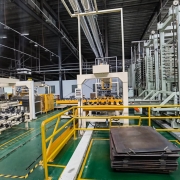Wie Sie die richtige Schablone für Ihre SMT-Anforderungen auswählen
Wie Sie die richtige Schablone für Ihre SMT-Anforderungen auswählen
Wenn Sie planen, eine Schablone für ein Projekt der Oberflächenmontagetechnik anzufertigen, sollten Sie einige Faktoren kennen, die Ihnen bei der Auswahl der benötigten Schablone helfen können. Diese Faktoren sind der Preis, die Form und die Abmessungen. Wenn Sie diese Faktoren berücksichtigen, können Sie die beste Wahl treffen.
Abmessungen
Eine Schablone muss die richtigen Abmessungen haben, um die Daten der Leiterplatte darauf unterzubringen. Dies wird als effektive Fläche bezeichnet. Dies ist der zentrale Teil der Schablone, der so zugeschnitten werden kann, dass er zu den Pads auf der SMT-Platine passt. Der verbleibende Raum um die Schablone wird als Schablonenrand bezeichnet. Die Schablone kann nicht über diesen Bereich hinaus geschnitten werden.
Es gibt fünf Haupttypen von SMT-Schablonentechnologien. Dazu gehören lasergeschnittene, elektrogeformte, chemisch geätzte und hybride Schablonen. Chemisch geätzte Metallschablonen sind sehr nützlich für Stufenschablonen. Diese Schablonen werden auf beiden Seiten chemisch gefräst, und das Ergebnis ist eine fast gerade Wand mit einer leichten Sanduhrform in der Mitte.
Textur
Bei den Schablonen haben Sie viele Möglichkeiten. Sie können Schablonen kaufen oder sie selbst herstellen. Eine Schablone ist ein Design, das mit einem Plotter ausgeschnitten wurde. Die Qualität und Größe der Schablone hängt von den Einstellungen des Plotters ab. Vergewissern Sie sich vor dem Schneiden einer Schablone, dass Kraft und Geschwindigkeit richtig eingestellt sind. Die Kraft sollte ausreichen, um durch die Folie zu schneiden, ohne die klebrige Unterlage zu beschädigen. Die Geschwindigkeit sollte so hoch sein, dass die Schablone so schnell wie möglich ausgeschnitten werden kann. Wenn Sie jedoch zu schnell schneiden, können die Ecken der Rechtecke einreißen.
Die in der Oberflächenmontagetechnik verwendeten Schablonen werden in der Regel aus rostfreier Stahlfolie hergestellt. Sie werden mit einem Laser so zugeschnitten, dass sie auf das oberflächenmontierte Gerät passen. Diese Schablonen werden auf der Platine positioniert und zum Auftragen von Lotpaste verwendet. Die Schablone ermöglicht eine genaue Platzierung der Lotpaste, ohne dass manuelle Arbeit erforderlich ist. Darüber hinaus spart eine Schablone Zeit und Mühe.
Preis
Beim Kauf von Schablonen muss der Kunde darauf achten, eine Schablone zu finden, die für seine Anforderungen geeignet ist. Es gibt zwei wichtige Faktoren, die zu berücksichtigen sind: Schablonendicke und Plattendaten. Die Schablonendicke trägt dazu bei, dass sich die Paste von der Platine löst. Außerdem muss die Schablonengröße innerhalb der effektiven Fläche (EA) liegen, d. h. dem zentralen Teil der Schablone. Der Rest der Schablone wird als Rand bezeichnet, der nicht geschnitten werden kann.
Die Größe der Schablone ist ein wichtiger Parameter für jeden automatischen Lotpastendrucker. Verschiedene Leiterplatten haben unterschiedliche Innenmaße, und die Schablone muss an die Rahmengröße des Druckers angepasst werden.
Verfügbarkeit
Schablonen sind eine hervorragende Option für eine Vielzahl von Dekorationsprojekten. Ganz gleich, ob Sie einen Raum streichen oder ein Möbelstück mit einem einzigartigen Design versehen wollen, Schablonen können ein sauberes, klares Bild liefern. Im Gegensatz zu einem Pinsel sind Schablonen wiederverwendbar und halten jahrelang.

